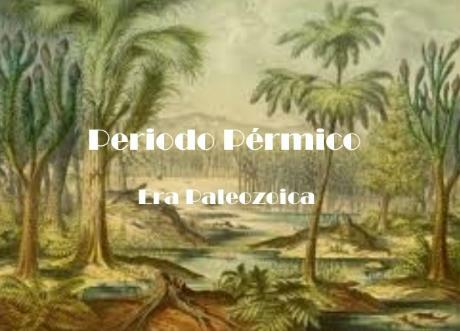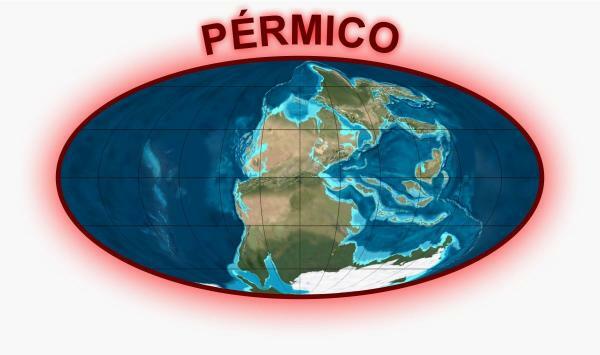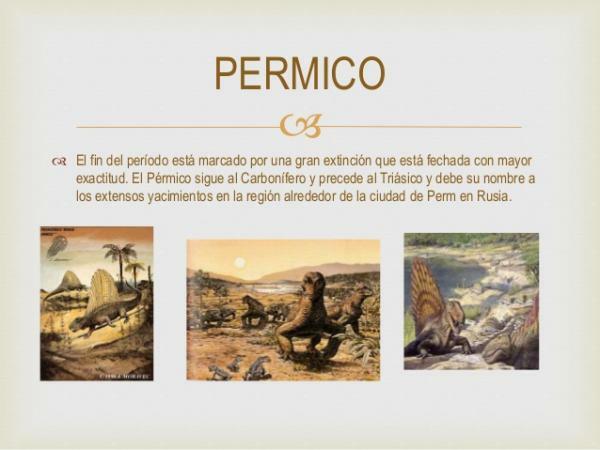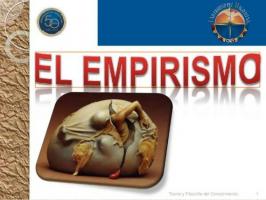Permian period: main characteristics

Image: SlideShare
When we talk about the different stages of prehistorygenerally our head relates them to the era of the dinosaurs, or the human ages of the Stone or the Metals, forgetting other important stages such as the Paleozoic Era. To comment on one of the main moments of the Paleozoic we must talk about the main characteristics of the Permian period.
The Permian is one of the periods in which the Paleozoic era, This being an era divided into 6 stages, and the Permian occupying the last place serving as a bridge to the Mesozoic Era.
The Permian gets its name from a Russian city, which is known as Perm, since it was the place where this period of Earth's history was discovered, this happening in 1941.
Regarding its chronological situation, we can place it between ago about 299 million years and about 251 million years ago. Being in recent years both the end of the Permian and the end of the Paleozoic Era. These last years were marked by the call mass extinction Permian-Triassic, considered the greatest extinction in the history of mankind, with 90% of marine creatures and 70% of the inhabitants of the earth's surface disappearing.

Image: Prehistoric World
Like all periods of Prehistory, the Permian has a series of subdivisions, each of them being characterized by something that differentiates them from the others, and whose evolution is vital to understand the main Permian characteristics. In total, the period has three subdivisions, which in turn are divided into others.
Cisuralian
Also know as Lower Permian, it is the first of the Permian subdivisions, being the one after the Carboniferous period. It is situated between 299 million years ago and 270 million years ago. Its name derives from the Urals, because it was the place where the first remains of this period were found. Its main characteristics is the appearance of calls conodonts, being a series of marine creatures that survived until the Jurassic. The Cisuraliense is divided into the following substages:
- Asselian
- Sakmarian
- Artinskian
- Kungurian
Guadalupian
Also called Middle Permian, is the middle part of the Permian subdivisions. It is situated between ago 265 million years and 270 million years ago. Its name comes from the Sierra de Guadalupe, a mountainous formation in the Texas area. Like the rest of the stages, it also has a series of subdivisions, being the following:
- Captain
- Wordian
- Roadian
Lopingian
Also called Upper Permian, is the last of the Permian sub-periods and the one that gives rise to the Mesozoic Era. It is situated between 265 million years ago and up to about 251 million years ago. Its name comes from the Chinese city of Leping in the Asian province of Jiangxi. The end of this period coincided with the Permian-Triassic mass extinction, the largest extinction in the history of our planet. On the other hand, the subdivisions of the Lopingian are the following:
- Changhsingian
- Wuchiapingian

Image: Slideshare
To conclude with this lesson on the Mesozoic Era we must talk about the most outstanding elements of this period and thus understand the great differences that existed at this time compared to others of the Prehistory. The main characteristics of the Permian are as follows:
- The Earth came from an important glaciation, so the remains of this although could be found on our planet. The poles were covered in ice, and it was not until millions of years later that the increase in temperature would cause them to disappear.
- The world was divided into two supercontinents, the so-called Pangea and Siberia. On the other hand there was only a sea, the so-called Panthalassa. Over the years, Pangea and Siberia became increasingly united in a greater way, forming a supercontinent that is what we generally call Pangea.
- The weather was very extreme, finding both areas with very high temperatures and areas of great cold, generally at the poles. By the end of the Permian this had changed to a great extent, with a warmer, drier climate prevailing with a great predominance of deserts.
- The more classical amniotes were divided into 4 groups of species, whose existence was maintained throughout the centuries. These groups were the mammals, turtles, archosaurs and lepidosaurs.
- The increase in arid areas led to the disappearance of a large number of water sources such as swamps, which reduced the species of amphibians and ferns.
- In marine fauna, the mollusks and echinoderms, although many algae and sponges were also found in much of the European area. The most primitive fish were no longer so numerous, and the predominance in the seas was for sharks and bony fish.
- The more modern insects, beginning a series of tasks of great ecological importance that have been maintained to this day.
- The terrestrial fauna was dominated by amphibians and by the first large reptiles. Although at the end of the Permian the first archosaurs, those that would later evolve into the important dinosaurs.
- Vegetation increased throughout the world, being the gymnosperms those that dominated the terrestrial vegetation.
- At the end of the period the greater extinction of species of the history of our planet, causing a series of problems that would last for millions of years.

Image: Slideshare



